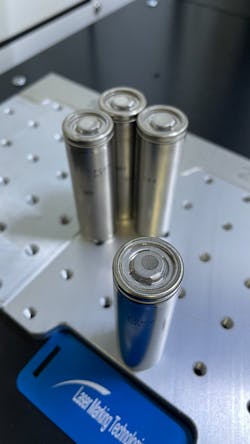Innovative EV Battery Cleaning Process Accelerates Production
Download this article in PDF format.
Nearly all EV batteries are shipped from overseas, exposing each individual cell to varying levels of contamination by the saline levels on ships. Without proper anode, cathode, and busbar cleaning these contaminants can result in poor or ineffective connections during the wire bonding process, which results in shorter or less efficient battery life.
It is possible to mechanically scrub or electropolish contaminated battery parts, however, these alternative methods come with environmental issues that lasers manage to bypass.
Cleaning battery components with a laser system allows manufacturers to work quickly, and in an environmentally safe way while controlling the ablation process down to 1 to 3-micron layers of material removal. This makes it easier to keep the substrate layer intact resulting in connections that are far superior to non-cleaned areas, while drastically improving bond durability over time and miles.
Laser ablation is a breakthrough EV battery cleaning technology because it has the ability to enhance conductivity between the battery cell and the bonding wire. Typical manufacturers commonly use a standard pulsed fiber laser with a conventional optical delivery to clean EV batteries. This strategy is a great multi-purpose strategy, but it doesn’t cater specifically to the EV market.
In order to service those who are championing versatile and large-scale EV battery operations, Laser Marking Technologies has developed an industry-specific laser system that is engineered to address the EV battery market with targeted beam delivery options designed with micro ablation capabilities not used by other manufacturers.
The Innovative Process
The engineers at LMT who have worked with many EV startups have experienced and identified the pitfalls in the EV battery module manufacturing process directly. As a collective group, they have brought together their world-class vision and optics team to the challenge and developed a new and industry-changing system called QuadraView, which is an intelligent machine multi-camera vision system.
The QuadraView system leads the industry by identifying one of the main shortcomings in battery module manufacturing, which is the loose, non-fixtured placement of cylindrical cells such as the 21700 cylindrical battery (which specifically refers to 21 for 21-millimeter battery outer diameter; 70 for 70-millimeter height, 0 for cylinder shape) when these cells are typically integrated into the husk or module they are physically set and then an epoxy type resin is introduced to the cell field.
Upon curing the cells are permanently locked into position. This is where some of the challenges arrive—exactly where the cathode and anode are in the matrix of cells and in relation to the bus module.
LMT’s four-camera QuadraView Intelligent machine vision system essentially creates a stereo image and identifies the specific characteristics of the Anode and Cathode and the subsequent fiducials located in the bus module, thereby allowing the ablation process to be performed exactly where the cell may have slightly drifted to in the resin curing process.
This advancement takes the previous steps of measuring the module in a subsequent operation and combines both measuring and laser ablation in one singular machine, thereby reducing the overall footprint of the machine array in a battery module manufacturing facility and most importantly removing the discrepancies that can be found when moving modules between location to location and tracking.
The XL EV with the QuadraView option is designed to enhance and accelerate the battery cleaning process. It is configured to find the optimal parameters for EV battery cleaning.
This network allows the laser to locate the areas of the cell and bus module that need to be targeted prior to initiating the laser ablation process. Ultimately, with fiducial locations in place, this allows manufacturers to create an automated process that delivers precise and complete results with a higher bond rate at the lowest resistance every time in a more compact footprint.
Cleaning the cells on EV batteries is an extremely sensitive process. But the XL EV can remove as little as 1.5 to 2 microns of material per pass, which affords users substantially more control than competitive systems. Machine and electro cleaning are much less controllable options than XL EV laser systems. Additionally, most laser cleaning systems use an X/Y Gantry system while cleaning batteries. And, for many applications, this approach is sufficient.
But some clients require extremely fast and efficient cleaning systems, which is where the XL EV system stands out. Not only can this system use a standard X/Y Gantry process, but it can also engage in a cycle that covers the entire battery with a fixed head solution. With the help of mirrors, the XL EV is capable of cleaning the entire battery without ever moving the scan head or the battery.
By developing a system with two different operating strategies, LMT is providing clients with the ability to customize their EV battery cleaning solution to accommodate specific volume levels and sensitivities.
There are alternatives to laser cleaning in the EV market, but the alternative options are much more time-consuming and more likely to damage the substrate material. LMT has developed technology that not only cleans EV batteries but can also be used to “texture” the surface to increase bond strength. The EV battery-specific system that was developed by LMT has the ability to transform the pace at which EV batteries are prepared for the wire-bonding process.
Those who are gearing up to manufacture large batches of batteries can greatly benefit from technology like the XL EV. In order to prevent poor battery connections from hindering the manufacturing process, customers can rely on the expertise of LMT to deliver customized and reliable EV battery cleaning results.
Laser Marking Technologies also has a proprietary software program that can easily be adjusted to accommodate a variety of needs. This software allows manufacturers to shift the process as they work, or to program-specific parameters into the system in order to deliver quick results. While preparing to mark QR codes, for example, the program is capable of translating the text into a QR code with a simple click.
This program takes much of the guesswork out of converting human-readable text into QR codes. And, when paired with the appropriate user, it has the ability to communicate with the XL EV laser to locate and clean each individual battery cell.
Once the fiducial is identified, it can be used by the x and y-axis to locate specific regions of the battery. This is often necessary as individual battery cells are not always located in a fixed position within the battery husk. Ultimately, the fiducial location allows manufacturers to create an automated process that delivers precise and complete results.

